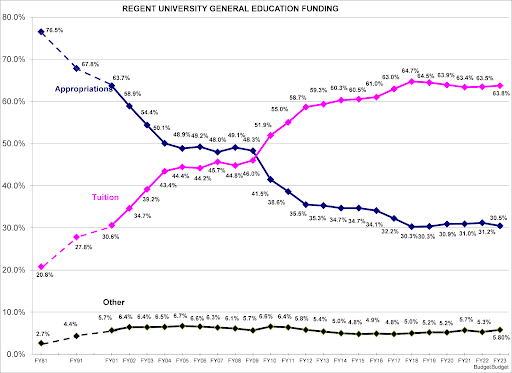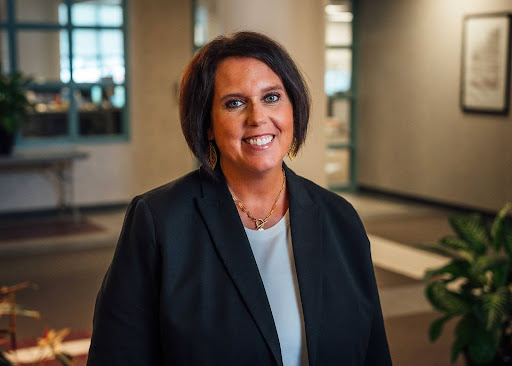Regent universities respond to inflation with 4.25% tuition increase

SARAH BOGAARDS Aug 3, 2022 | 1:43 pm
5 min read time
1,087 wordsAll Latest News, Business Record Insider, EducationThe above chart shows the revenue streams that make up the Regent University General Education Operation Fund and how much each has contributed to the fund for every year since fiscal year 2001. The fund totals $1.145 billion for fiscal year 2023, with tuition revenue representing 63.8% and state appropriations representing 30.5%. To view the chart on the Iowa Board of Regents’ website, click here. Graphic courtesy Iowa Board of Regents
In its last meeting before students return to campus for the fall semester, the Iowa Board of Regents unanimously approved last week a 4.25% tuition increase for undergraduate students at the state’s three public universities.
Students at each university will pay about $300 more per year under the new tuition rates. State appropriations to the regent universities increased $5.5 million this year, or 1.1%. The board requested a $15 million increase in funding from the Iowa Legislature following a year of flat funding in 2021.
The increase also comes amid inflationary cost increases for universities. The proposal for the tuition increase cited “growing financial challenges” and said the new tuition rates will help address inflationary cost increases, retaining and recruiting faculty and staff, deferred maintenance of facilities, and student financial aid opportunities.
Bryce Kanago, associate professor of economics at the University of Northern Iowa, said the regent universities are experiencing higher costs for utilities and food, but the top challenge is navigating the “labor-intensive” nature of higher education institutions with the present demand for workers and higher wages.
“Especially as you think about things like how much universities might have to pay now to work-study students, given their opportunities to work elsewhere, [and] clerical and professional staff, given their opportunities to work elsewhere at higher wages, that’s put upward pressure” on wages, Kanago said.
The combination of inflationary pressures and lower-than-expected state funding has put the board in a position of needing to raise tuition more to help cover increasing costs.
During the June 20 meeting of the Board of Regents, representatives of the universities’ student governments provided their input on the proposed tuition increase.
“In regards to the proposed tuition fee rates it’s clear to myself that circumstances have forced the board’s hand as less than desirable appropriations in the state make it impossible to maintain both our current rate of tuition and our high level of academic quality at our institution,” Jacob Ludwig, president of Iowa State University’s student government, said in his statement at the meeting.
“Students and friends I’ve known for a long time had voiced their concerns not knowing where to turn to be able to afford continuing their education,” said Leila Masinovic, president of UNI’s student government. “Many of them know that as this degree gives them an education, it also secures their ability to build a great future with their families, and in return give back to the community that has helped them get to where they are. … This unfortunate circumstance of a promising individual not being able to attend college because of rising costs will only be a great disadvantage and hindrance to our society.”
This year’s 4.25% increase exceeded the 3.7% projection midpoint from the Higher Education Price Index, whereas in recent years tuition increases have been below HEPI projections on average.
The Commonfund Institute computes the index annually, which measures the costs of higher education, and future years’ projections are calculated by the economics department at the University of Iowa’s Tippie College of Business.
Kanago said one reason the increase for this year was higher is the board has to account for the fact that tuition can only be changed once per year.
“It also means that when tuition changes that they’re somewhat making up for the fact that inflation was higher than anticipated over the last year, so some of that is looking back on [how] costs have gone up more than people would have anticipated and also thinking that over the course of the next year, prices are going to continue to rise at a faster rate,” he said.
However, Kanago found that, relative to inflation, tuition increases over time have been “modest.”
Comparing tuition rates in 2010-11 that were adjusted for inflation and those for the 2022-23 school year including the 4.25% increase, Kanago calculated that over this time tuition for students at Iowa State University and the University of Iowa has grown by more than the consumer price index. He said students at both universities will spend about $400 more in tuition this academic year than if tuition had kept pace with the consumer price index.
UNI students will pay about $200 less than if tuition had grown at the same rate as the consumer price index over the last 12 years.
While the percentage increase in tuition was larger than previous years, it remained below the 9% inflation rate, meaning neither of the regent universities’ main revenue streams kept up with inflation this year.
“If you have tuition going up by less than inflation and if you have state appropriations going up by much less than inflation and there’s not a lot of other sources of revenue, then that implies that in terms of purchasing power, in terms of inflation-adjusted dollars, the universities have less,” Kanago said.
Comparing data from 2010 and 2021, Kanago found that state appropriations for general university funds was 17% lower than it would have been if it kept up with HEPI. Using the 2022 HEPI projections and assuming no change in enrollment, the figure grew to 20%, according to his calculations.
Last week the board also unanimously approved a $6.9 billion budget, which includes a $1.145 billion general university education operating fund. The fund comprises 63.8% tuition revenue and 30.5% state appropriations.
The above chart shows how the funding distribution for the general operating fund has flipped over time to about two-thirds tuition revenue and about one-third state appropriations.
At the board’s June meeting, the president of UI’s undergraduate student government, Patrick Johnson, called for the board and the Iowa Legislature to work together to “create systemic change necessary to provide accessible, affordable education to any student who pursues it.”
“Throughout recent years, we’ve seen economic burdens of higher education shift away from our state Legislature and onto the backs of young adults fresh out of high school. … It’s our duty as educational and state leaders to review the financial burdens we place on our students and ensure that these expenses fund essential, useful and desired services across our campuses,” he said.











